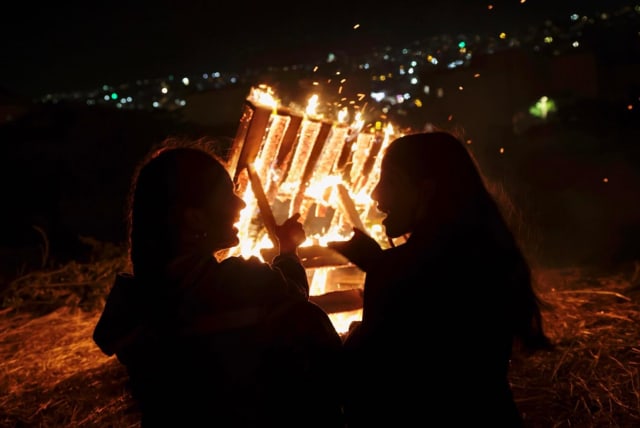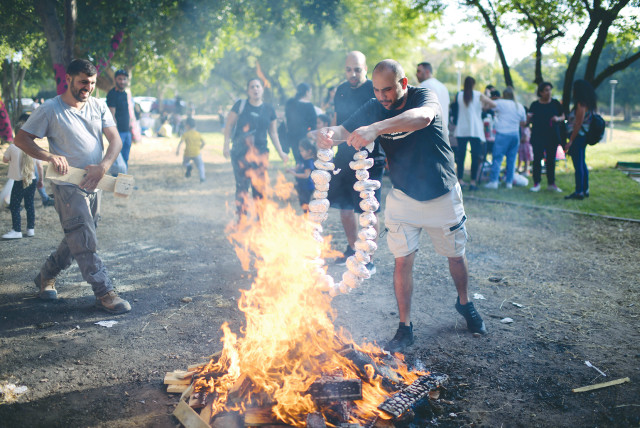14 times more air pollution in Ramle from Lag Ba'Omer bonfires

The Environmental Protection Ministry has called on Israelis to refrain from lighting these fires and asked them to celebrate in other ways due to their negative environmental impact.
The Israeli mixed city of Ramle had 14 times more air pollution overnight Monday compared to a clear day due to Lag B'Omer bonfires, according to the Environmental Protection Ministry.
There is a Jewish tradition to light bonfires on Lag B'Omer to commemorate the miracle of Rabbi Shimon Bar Yochai exiting the cave he had been hiding in for 12 years on this day. In addition, tradition says that his followers lit torches outside at the rabbi's grave on the anniversary of his death, among other reasons.
However, in recent years, the Environmental Protection Ministry has called on Israelis to refrain from lighting these fires and asked them to celebrate in other ways due to their negative environmental impact. For example, bonfires can produce greenhouse gases, other poisonous gases, and fine particles that can negatively impact human health.
The ministry's national air monitoring system has more than 200 stations nationwide to check air quality. In general, there was a decrease in total average air pollution caused by bonfires this year than the previous year. However, there were significant spikes in particles smaller than 2.5 microns (PM2.5) - about 3% the size of a human hair - and smaller than 10 microns in several cities.
Ramle saw the highest increase in PM2.5, more than double any increase in any city from the previous year. In Ashkelon, 8.9 times more pollution was measured compared to a clear day, 4.5 times more in some regions of Haifa and 4.4 times more in some neighborhoods in Jerusalem.
The increase in particles began in the evening and peaked between 10 p.m. and 4 a.m., according to the monitoring system.
One of the most striking features of fires is the significant increase in the concentration of PM2.5. On a typical day, these particles make up about 50% of particles smaller than 10 microns. However, this ratio changes during fires, and the concentration increases to as much as 88%.
Health risks associated with the higher concentrations
PM2.5 pose more of a health risk than larger particles because they can be absorbed deep into a person's lungs or even the bloodstream.
Israel falls into the World Health Organization's "moderate" pollution rating bracket regarding the amount of PM2.5 particles in the air on average days, with an average of 20.83 µg/m3. Moderate ranges between 12.1 and 35.4. WHO has said that any level of PM2.5 over 10 µg/m3 can cause adverse health effects, especially among more vulnerable portions of the population.
The Environmental Protection Ministry said that the location of the bonfires relative to the monitoring stations and meteorological conditions, such as the speed of the wind, among other things influences measured particle concentrations.
Other cities that saw significant spikes in pollution overnight included some areas of Bnai Brak at four times as much, and Moshav Nir Yisrael, which had nearly nine times more pollution.
The Environment and Climate Change portal is produced in cooperation with the Goldman Sonnenfeldt School of Sustainability and Climate Change at Ben-Gurion University of the Negev. The Jerusalem Post maintains all editorial decisions related to the content.
Jerusalem Post Store
`; document.getElementById("linkPremium").innerHTML = cont; var divWithLink = document.getElementById("premium-link"); if (divWithLink !== null && divWithLink !== 'undefined') { divWithLink.style.border = "solid 1px #cb0f3e"; divWithLink.style.textAlign = "center"; divWithLink.style.marginBottom = "15px"; divWithLink.style.marginTop = "15px"; divWithLink.style.width = "100%"; divWithLink.style.backgroundColor = "#122952"; divWithLink.style.color = "#ffffff"; divWithLink.style.lineHeight = "1.5"; } } (function (v, i) { });

